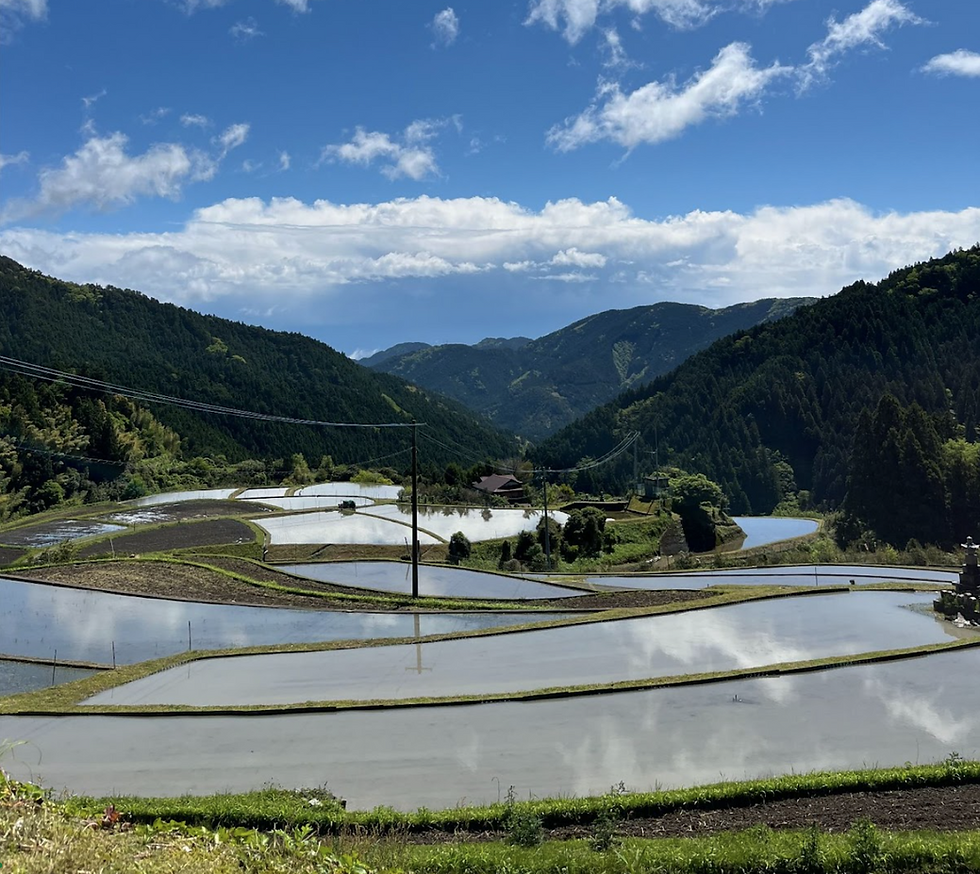Japan's Zero-Waste Town: The Art of Recycling in Kamikatsu, Tokushima
- Evan Lai
- May 17
- 3 min read

Not a Manga Series
When you search up ‘Kamikatsu’ online, you might find a Japanese manga that was recently adapted into an anime series. And while that comprises a different facet of art, the concealed village of Kamikatsu in Tokushima offers a unique glimpse into a town with zero waste – one of the few of its kind around Japan, and even rarer around the world. I visited this zero waste town in April, learning about where everything goes after leaving our hands.
The Good and Not-So Good

Kamikatsu was not always the sustainable utopia it is today – just 30 years ago, incinerators would burn up waste by the ton, spreading smoke all over the mountainside. People would treat the Katsuura River like a bin in their backyard, throwing out trash and watching it flow into oblivion. Today, Kamikatsu has evolved beyond the best recyclable programs of the world: and not with a nouveau, trailblazing mechanism; simply a 45 category recycling system that breaks down waste into every subcategory possible. From tyres, to the different kinds of green, brown and clear glass, to mixed plastic to ceramics, everything is given a new life that is eventually reintegrated within society.
This is made possible through the Kamikatsu Zero Waste Center: allowing the town to recycle upwards of 80% of their waste, leaving a small portion of organic byproduct to be converted to fertilizer and an even smaller portion to be incinerated, leaving no trace of excess. Many unused materials are used in art and architecture around the village.
The Waste Center itself exemplifies sustainable ideals, utilising literal doors and windows to construct its exterior facade. Broken porcelain is used in carving out sections of the mountain, reinforcing the soil and ensuring protection from landslides. The full circular trunk of trees are also used, rather than sectioned-out columns that are used in traditional woodworking construction.

The Art of Recycling
The ageing population of the town has grown to a local concern: with half of the 1,400 of its residents above the age of 50. However: this has also allowed a unique type of art to flourish, which is single-handedly brought alive by the elderly: using koinobori (Japanese crafted flying fish) fabrics to weave together kimonos and other small ornaments, cutting up jeans and making them into stools, or even using lotus seed pods to make colourful trinkets. The style is radiant, repetitive and almost hypnotic: a collage of different textures that are removed from their original function and reshaped into a different object.


Golden Age of…Leaves?

While the recycling program has gained recognition on a number of social media platforms, even less is known about the irodori business of Kamikatsu. The irodori business manifests to varying degrees in all Japanese restaurants: a synecdoche for the overlooked importance of Kamikatsu. Irodori refers to the leaf business invented by Kamikatsu: the decorational maple leaves placed by tuna bowls, or the fried wasabi leaf in a platter of tempura.
Historically, the leaf business was never meant to even be a real business.
After the Second World War, citruses became increasingly valuable across the country, causing the widespread introduction of cedar plantations around the countryside. However, as imports became cheaper and cheaper, there was no competition for the local trees, causing farmers to abandon most of them. Instead, an increased demand for decorative garnishes in Japan allowed the abundance of flora in Kamikatsu to flourish as a functional business even for the elderly – with Kamikatsu now supplying over 80% of the leaves used in Japanese restaurants today: all done by a handful of people. The business itself is tedious but rewarding, for example, a perfect lotus leaf could sell for 1000 Yen, and farmers could sell up to 2,000 during peak season. The leaf economy also operates uniquely. Rather than the market setting the price for leaves, restaurateurs are required to indicate the number and species of leaf they require, and allow farmers to name their price. This ties into the zero-waste philosophy of the town, reaffirming a positive outlook on using less and eliminating the possibility of waste. Farmers must be meticulous with their exports: leaves must be fully symmetrical and within certain length and width restrictions with no breaks or folds – they otherwise risk business complaints, which can hinder production. Irodori is now a 2.6 million USD business in Kamikatsu alone.
Kamikatsu: Beauty in Simplicity

Whether it be for the plating art, the terraced rice paddies, the tranquil gushing of the Katsuura or simply the existence of one in such an environment, Kamikatsu fulfills the sustainable ideal that so many in power aspire to achieve. And it was not some avant-garde policy that enabled it to flower, just the old fashioned tedium of categorizing and adapting to a slightly more complex lifestyle. The town is a testament for the ability of widespread change beginning with the smallest of sparks, an introspective reflection of individual empowerment.





Comments